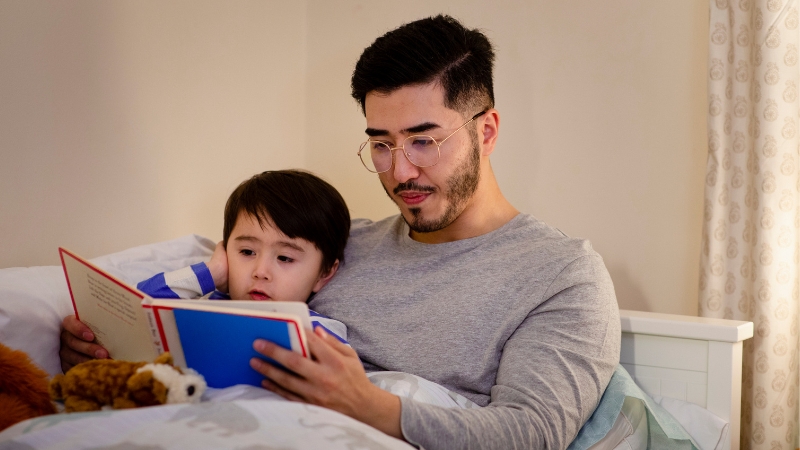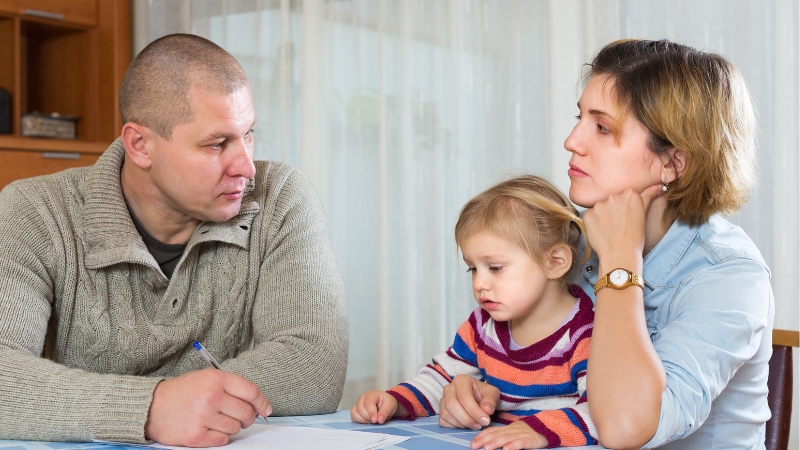Routines, routines, routines: they’re the backbone of daily life, but have you ever considered how they apply to your co-parenting? It can be tough to get into a rhythm when you’re coordinating between separate households, but we’re here to tell you it IS possible and worth the effort! As we turn the page into 2023, let’s start things off on the right foot by exploring how to build a routine that works for your whole family.
The Gist
Routines allow us to function at our best by providing structure and predictability. As a co-parent, routines can help your life with your parenting partner and child run more smoothly, establish clear boundaries and expectations, and avoid confusion and ambiguity. Essential elements to consider when developing your routines include: sleep, nutrition, exercise, hygiene, and socialization/emotional connections. To reap the maximum benefit for you, your co-parent, and especially your child, work together to coordinate your routines.
This does not mean they have to be identical; you can allow for some variation based on your individual preferences and strengths, but general consistency in key areas will be most effective. As you experiment with your routines, observe and take note of their impact on everyone’s behavior, and make adjustments as you see fit. If you and your co-parent struggle to get on the same page, you can still achieve consistency with your routine. Teach your child to follow them by explaining them verbally and through pictures, modeling them, and praising compliance.
Why routines?
We humans are creatures of habit. Our brains are designed to maximize efficiency by picking out patterns and programming them into us so that they become automatic and we don’t have to waste effort thinking about them. Our minds and our bodies are at their best when we follow regular routines. This consistency is especially important for young children, whose regulatory systems are not yet developed and need guidance to reach homeostasis. On an emotional level, routines also provide comfort and safety in their predictability. Furthermore, they can build competency and confidence; when you practice the same routines over and over, you can master the skills involved.
Chances are, you keep certain routines without even thinking about them! And most likely, you’ve observed their importance when you’ve broken with them. For example, if you stay up late, you’ll feel the lack of sleep throwing you off your game, or if your child doesn’t get that third story before lights out, they’ll struggle to settle down at night.
Routines can be an especially useful tool as you navigate the complex dynamics of your relationship with your parenting partner. They can provide a structure for you both to fall back on; instead of arguing over “my way” or “your way” of doing things, the routine itself can serve as your guide. Even if you’re not able to come to an agreement, your own routine can keep you grounded throughout conflict and uncertainty.

The Basics
Oftentimes routines revolve around our most basic needs: nutrition, exercise (mental and physical), sleep, hygiene, and socialization/connection. Reflect on your day-to-day habits, both when your child is in your care and when you’re without him/her. Are you intentional in how you approach these areas? Do you keep consistent eating/sleeping habits and times? Do you have a balance of energy-releasing and energy-restoring activities? Stimulating and relaxing? What about opportunities for bonding and connecting with others? Starting with these categories can establish a strong framework for your day-to-day schedule.
Learn More about how co-parenting routines can revolve around our most basic needs.
Transitions
Another area to consider is transitions. Sometimes when we think about routines we focus solely on the activities in our schedules, not the shifting of gears between them. But transitioning can be challenging for adults and children alike and requires just as much planning. How do you handle moving between activities and locations? For example, how do you shift between high-energy activities (for example, soccer practice) and lower-key ones (homework, reading, bedtime)?
Furthermore, how do you shift between different environments such as work and home? School and home? This may be of particular importance when you and your parenting partner are separated and share custody of your child. How do you deal with events such as drop-offs at school, going from work to home, hand-offs for visitations, etc.? Keeping a predictable pattern will make these events easier for your child. You may also want to structure these transitions in particular so that you engage in re-connecting or bonding activities (one-on-one time, perhaps) before and after.
Other Considerations
Other components to think about include: chores and necessary tasks, for you and your child, including cleaning, household maintenance, finances, homework, etc. Most likely you’ll also need to build in time for extracurricular activities or hobbies, too.
Be sure to consider age, personality/temperament, sensory preferences/threshold, developmental level, learning style, etc. when building your routines. As your child grows, you will also want to involve them more in the decision-making process.
Broaching the subject with your co-parent
If our intent with establishing routines is to create a comforting sense of predictability, then it follows that we should also try to keep those routines consistent between households. You may have worked through some of this in developing a parenting plan, which we cover in our training course. If you haven’t, find time to discuss this with your co-parent. This could happen naturally if you both communicate effectively at present. However, if doing this feels uncomfortable to you, you may need to plan how you’ll broach the subject in advance.
Here Are Some Suggestions
Approach with curiosity
Rather than stating or directing, ask questions and use phrases such as “I wonder.” For example, instead of saying, “We need to get on the same page with our routines,” you might lead with, “I’m wondering about our child’s sleep. What do you do at bedtime when she’s with you?” In this way, you start from a neutral position, rather than from a place of judgment. In our training course, we cover more examples of how you can ask questions using the “I” statement.
Allow for some variability
General consistency of routines between households doesn’t mean they need to be exactly the same. You and your parenting partner are two different people, each with your own unique traits that you bring to your relationship with your child, and that’s not a bad thing! You can still embrace those differences while keeping within a general structure. For example, you both ensure that your child goes to bed around the same time every night and that you have some bonding built in. But maybe your co-parent prefers singing songs while you’d rather read, or perhaps you’re comfortable snuggling together in your room but your co-parent wants to remain in your child’s for the entirety of the routine. Or, maybe your schedules are slightly off but the tasks remain the same. For example, you both make sure your child completes homework, but you work later and want to spend evenings connecting with your child so you make sure he does it the next morning instead.
Acknowledge strengths
If your parenting partner handles certain routines well, then say so! There may be skills that you can learn and apply in your own parenting. Plus, this recognition will likely make your co-parent feel good and will bring positivity to your relationship.
Bring in a neutral party
Enlisting the assistance of professionals (such as pediatricians, school personnel, therapists, parenting coaches, etc.) may remove some of the power struggles between you. Their expertise will also benefit both of you.
It’s possible that your parenting partner may not wish to collaborate with you, or you may not come to an agreement about how your routines should run in each household. That’s ok! At the very least, in bringing up the topic you may be able to gain valuable insight into how things work when your child is away from you. Most importantly, you can still build your own routine and work on consistency when your child is with you. Your child will come to understand and compartmentalize the different expectations.
Conducting a self-study
Routines should help everything run smoothly from day to day and should keep everyone on a relatively even keel. But as we’ve noted before, individual needs vary. So how do you know if your routine is working for you? First, conduct a self-study. Maintain a running record of your routines and behaviors for a few weeks to see if you notice a correlation (positive or negative). For example, if you note that your child tantrums and melts down every day before lunch, you may consider bumping up the timing of the meal to avoid hunger-induced misbehavior.
Conversely, if you begin a ritual in which you play in your child’s room for a few minutes before tucking him into bed and you notice that he settles down more quickly and wakes less often than before, you might conclude that giving the bonding time has a positive impact on his sleep. A word of caution here: there can be many factors that influence behavior, and your routine is just one of those factors. Be careful not to assume that your routine is the direct (or only) cause for what you’ve observed. Also keep in mind that change takes time and can be uncomfortable at first, so allow for a few weeks of consistent implementation of your routine before you tweak it.
Another sign that you might need to reconsider your routine would be if parts of it bring feelings of dread or instigate power struggles with your co-parent or your child. If you’re spending more time fighting over the routine than you are executing it, then it may not be worth it and you may wish to do things differently. For example, if for a few weeks, you’ve been asking your child to do homework immediately after school and every time your child has been unable to do so, then you may decide to allow him/her some downtime first and try homework later in the afternoon. Or if you notice that your parenting partner has been struggling to visit the child during scheduled times then you may want to suggest a time change that best fits both schedules.
Studies have also found that positive parenting may reduce the impact of stress on the brain and can mitigate the impacts of traumatic or challenging events… including parental separation and divorce.

Here is where Koh-Parenting Services comes into play!
Invest in yourself today with our healthy co-parenting program
Teaching routines to your child
Work with your parenting partner to outline the routine for your child. Through consistent repetition, your child should typically be able to learn them. You can also facilitate their understanding through some of the following strategies:
- Verbal explanations: talk them through it.
- Role-modeling: show them what to do.
- Practice: “Pretend-play” your routine with your child, helping him/her practice it.
- Visual supports: Supplement their learning with visual cues such as picture schedules, step-by-step picture instructions, chart checklists, etc.
- Positive reinforcement: Provide specific positive reinforcement for behaviors that align with your routine. Start by recognizing even small steps toward mastery.
- Scaffolding: Work alongside your child, hand-over-hand if necessary, to coach them through any tasks or parts of the routine that you’d like for them to learn to do independently. Gradually decrease your level of support until your child can complete the steps without your assistance.
If despite your best efforts, you and your parenting partner are unable to come to a consensus and your routines are vastly different, you can still teach your child to follow your expectations. Here’s how:
- Review the differences between your household routines with your child.
- Help your child to organize information by breaking it down into specifics; for example, “At Dad’s house you….,” “At mom’s house you…”
- Gather as many details as you can about your co-parent’s routine. You can use the knowledge to support your child’s adherence to that routine. You may also find that the information helps predict how your child will respond to you and your way of doing things when he/she returns to your household.
- Build in additional time for acclimatization. It can be confusing for your child to switch between two different lives. Allow him/her some downtime to shift gears. This may also mean that you make sure you’re available (physically and emotionally) to provide support and connection around transition times between households.
Taking charge of your day-to-day routines allows you to take charge of your life.




